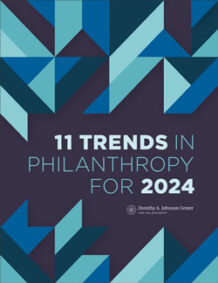With Crisis Comes Change: Black Women and the Glass Cliff


 This article was first published in our 11 Trends in Philanthropy for 2024 report. Explore the full report here.
This article was first published in our 11 Trends in Philanthropy for 2024 report. Explore the full report here.
Want the latest trends, research, and more delivered right to your inbox? Subscribe to the Johnson Center email newsletter.
Even under the best circumstances, leadership transitions can be unsettling for both the organization and the leader. As the National Council of Nonprofits noted, “Whether a transition occurs due to an unexpected vacancy on the staff or board, or the anticipated transition of a long-tenured leader, being deliberative and thoughtful, and having a plan in place, can help a nonprofit weather the inevitable challenges of leadership transition” (n.d., para. 2).
For some leaders, these transitions can be particularly challenging — and risky. The concept of the “glass cliff” — first coined by authors Ryan and Haslam (2005, para. 9) — refers to the tendency for women and racial/ethnic minorities to be appointed to leadership positions during times of crisis. The theory based in this research explains that these individuals are essentially set up to take the blame if the company fails or continues to struggle, even while the organization itself is able to boost its reputation as modern and enlightened (Kagan, 2022).
With more and more people of color, and especially Black women, appointed to leadership positions following the crises of 2020, we’re seeing the glass cliff attracting greater attention and concern in research, commentary, and conversation. Faced with struggling organizations, reduced time to perform, and insufficient support, leaders are finding themselves in untenable situations.
Even before 2020, data from the Race to Lead series of reports from the Building Movement Project (BMP) (2021) — which call upon datasets gathered in 2016 and 2019 — demonstrated the particular challenges faced by leaders of color and, especially, Black women. For, as Tiffany Tate pointed out in a 2021 interview with Forbes, “As a result of the intersection of race and gender, Black women are uniquely positioned to face ‘double bias,’ or ‘double jeopardy’ in the workplace” (Seale, 2021, para. 4).
According to BMP’s 2019 report, Race to Lead: Women of Color in the Nonprofit Sector, their 2016 Nonprofits, Leadership, and Race Survey found that Black women were the most likely (43%) of all demographics to say their race had negatively impacted their career advancement (Biu). As summarized by Sydney Trent for The Washington Post (2021), in this study “Black women cited lower pay, being overlooked for jobs and promotions, lack of mentorship, dealing with assumptions that they are underqualified, and being stereotyped as ‘angry Black women’” (para. 13).
“[O]ver 50% of Black women felt they were treated discourteously at work, did not feel part of the team, did not have a shared sense of purpose, and did not receive care and support from others.”
Further, BMP’s 2022 report, Trading Glass Ceilings for Glass Cliffs: A Race to Lead Report on Nonprofit Executives of Color, noted that “nearly half (49%) of people of color indicated in the 2019 survey that their race had negatively impacted their advancement, up from roughly one-third (35%) in the 2016 survey” (Thomas-Breitfeld & Kunreuther, p. 5).
“The overwhelming consensus,” wrote Jen Douglas and Deepa Iyer in BMP’s 2020 report, On the Frontlines: Nonprofits Led by People of Color Confront COVID-19 and Structural Racism, “is that the current climate is taking an immeasurable psychological, physical, and emotional toll, especially on women of color leaders” (p. 4). Recurring pain points of note:
Following a white leader. The 2021 report, Making (Or Taking) Space: Initial Themes on Nonprofit Transitions from White to BIPOC Leaders, from BMP and the Robert Sterling Clark Foundation noted that most exiting white leaders or boards were recruiting leaders of color not only to lead the organization but to address internal issues of equity or racism. BMP’s 2022 report, Trading Glass Ceilings for Glass Cliffs, also found that “the data on the staff challenges of EDs/CEOs of color who followed white predecessors—combined with the data on the lack of DEI efforts being taken on by white EDs/CEOs—appears to bolster personal accounts by leaders of color who felt they inherited a staff team, board, and funder relationships that resist and resent being led by an ED/CEO of color” (Thomas-Breitfeld & Kunreuther, p. 18).
Boards of directors. ED/CEO relationships with boards of directors are often already fraught with power dynamics, evolving roles and responsibilities, and the strong personalities of individuals attempting to fulfill the needs of the organization. Research from BoardSource (2021) demonstrated that boards impact the job satisfaction of nonprofit EDs/CEOs in various ways, ranging from the extent to which the board adds value to strategic conversations to the amount of money board members contribute to the organization.
Many Black women leaders especially report increased scrutiny from their boards and unrealistic expectations. As noted by a Black female executive leader in the 2023 report, Brilliant Transformation: Toward Full Flourishing in BIPOC Leadership Transitions, “…we’re trying to shift it so that we have shared power and, at the same time, people are expecting me to come up with all the answers …Well the previous CEO didn’t solve all the problems all right now, why are you expecting me, all of a sudden, in my first three months to solve all the problems?” (Flores & Conte, p. 21).
The task of righting an organizational ship, experts say, can be so daunting that it quickly leads to burnout or even failure. As a woman of color participant in BMP’s 2021 study, Making (or Taking) Space, noted,
It’s just absurd. I feel like funders are so excited to have that moment [of hiring a leader of color] and be like, “Yay, look what’s happening.” And everybody’s like, “Yay,” and then they just walk away. And . . . in almost every case that I know of, a staff that has deep-seated issues of race and gender and gender identity that nobody has dealt with or unpacked. (p. 20)
Many Black women and other leaders of color have found themselves on the “glass cliff” since 2020. Yet the reality and dangers of the glass cliff have existed for far longer than that. Utah State University professors Alison Cook and Christy Glass set out to study the glass cliff a decade ago, only to identify a further phenomenon — that of the “organizational savior,” or the hiring of a white male to follow the ousted woman or person of color leader (Munson, 2013).
Grantmakers, nonprofit leaders, board members, and others should ensure that this next wave of executive transitions doesn’t just push more leaders of color over the proverbial glass cliff. As Scott Konrad pointed out for the Center for Association Leadership, “Nonprofits will need to contend with many challenges [in the years ahead] including labor shortages, inflation, donor hesitancy, rising costs, cyber threats, and falling endowments” (2023, para. 1). Nonprofit leadership work is demanding enough, without adding unnecessary barriers created at the intersection of gender and race.
Biu, O. (2019, February). Race to lead: Women of color in the nonprofit sector. Building Movement Project. https://9ca930.p3cdn2.secureserver.net/wp-content/uploads/2019/02/WOC_Race-to-Lead.pdf
BoardSource. (2021, June). Leading with intent: BoardSource index of nonprofit board practices. https://leadingwithintent.org/wp-content/uploads/2021/06/2021-Leading-with-Intent-Report.pdf
Building Movement Project. (2021, September). Making (or taking) space: Initial themes on nonprofit transitions from white to BIPOC leaders. Robert Sterling Clark Foundation. https://buildingmovement.org/wp-content/uploads/2021/10/MakingOrTakingSpace.pdf
Douglas, J., & Iyer, D. (2022, October 2). On the frontlines: Nonprofits led by people of color confront COVID-19 and structural racism. Building Movement Project. https://buildingmovement.org/wp-content/uploads/2020/10/On-the-Frontlines-COVID-Leaders-of-Color-Final-10.2.20.pdf
Flores, M., & Conte, E. (2023). Brilliant transformation: Toward full flourishing in BIPOC leadership. Robert Sterling Clark Foundation. https://drive.google.com/file/d/1Jb1oUku9TOXfNLmX_lGZMiWQIovRTfEJ/view?pli=1
Hines, E. & Fitts Ward, M. (2022, June). Black women thriving: BWT report 2022. Every Level Leadership. https://everylevelleads.com/wp-content/uploads/2022/06/Black-Women-Thriving-Report_2022.pdf
Kagan, J. (2022, December 7). Glass cliff: Definition, research, examples, vs. glass ceiling. Investopedia. https://www.investopedia.com/terms/g/glass-cliff.asp
Konrad, S. (2023, January 4). Four trends that will affect nonprofits in 2023. ASAE, The Center for Association Leadership. https://www.asaecenter.org/resources/articles/an_plus/2023/1-january/four-trends-that-will-affect-nonprofits-in-2023
Munson, K. (2013, July 18). Studies show women & minority leaders have shorter tenures, tenuous support. Utah State TODAY. Utah State University. https://www.usu.edu/today/story/studies-show-women-amp-minority-leaders-have-shorter-tenures-tenuous-support
National Council of Nonprofits. (n.d.) Succession planning for nonprofits/managing leadership transitions. https://www.councilofnonprofits.org/running-nonprofit/governance-leadership/succession-planning-nonprofits-managing-leadership
Ryan, M. K., & Haslam, S. A. (2005). The glass cliff: Evidence that women are over-represented in precarious leadership positions. British Journal of Management, 16(2), 81–90. https://doi.org/10.1111/j.1467-8551.2005.00433.x
Seale, C. (2021, March 25.) Beyond #BlackGirlMagic: Shattering systemic glass ceilings for Black women to succeed in the workplace. Forbes. https://www.forbes.com/sites/colinseale/2021/03/25/beyond-blackgirlmagic-shattering-systemic-glass-ceilings-for-black-women-to-succeed-in-the-workplace/?sh=13a8db2e4c49
Trent, S. (2021, July 11). A racial reckoning at nonprofits: Black women demand better pay, opportunities. The Washington Post. https://www.washingtonpost.com/local/social-issues/nonprofit-black-women-racial-discrimination/2021/07/11/e23cb810-d2da-11eb-a53a-3b5450fdca7a_story.html
Thomas-Breitfeld, S., & Kunreuther, F. (2017, December) Race to Lead: Confronting the nonprofit racial leadership gap. Building Movement Project. https://racetolead.org/wp-content/uploads/2017/12/RacetoLeadNonprofitRacialLeadershipGap-3.pdf
Thomas-Breitfeld, S., & Kunreuther, F. (2022, February). Trading glass ceilings for glass cliffs: A Race to Lead report on nonprofit executives of color. Building Movement Project. https://buildingmovement.org/wp-content/uploads/2022/02/Race-to-Lead-ED-CEO-Report-2.8.22.pdf